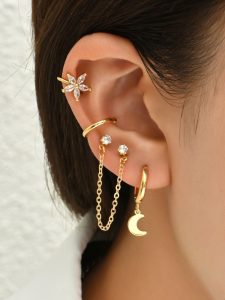One of the most common concerns individuals have after getting their ears pierced is when they can safely go swimming. It’s an understandable question, as swimming in pools, oceans, or even hot tubs can potentially put your newly pierced ears at risk of infection or irritation. In this comprehensive guide, we will provide you with all the necessary information to ensure a safe and enjoyable swimming experience after ear piercing.
Understanding the Healing Process
Before diving into the topic of swimming after ear piercing, it’s essential to understand the healing process of a new ear piercing. Initially, the area around the piercing will be tender, red, and may swell slightly. This is a normal part of the healing process and can last for a few days to a couple of weeks. During this time, the body forms a protective layer of skin around the piercing, sealing it off from potential irritants or bacteria.

The Importance of Patience
Swimming can introduce various elements that may hinder the healing process or even lead to infection. Because of this, it’s crucial to have patience and allow your piercing enough time to heal before exposing it to water activities. While each person’s healing time may vary, a general rule of thumb is to wait at least four to six weeks before going swimming.
Swimming in Pools
Chlorine is commonly used in swimming pools to keep the water free from bacteria and germs. However, chlorine can also irritate and dry out your skin, including the area around your newly pierced ears. To protect your piercing while swimming in a pool, we recommend following these precautions:
Avoid submerging your head underwater: Keeping your head above water will minimize the risk of water entering your ears and coming into contact with the piercing.
Wear a swim cap: If you prefer fully submerging in the pool, wearing a swim cap can create a barrier between the water and your ears, reducing the chances of irritation.
Clean your piercing after swimming: After your swim, gently clean your piercing using a saline solution or a mild, fragrance-free cleanser. This will help remove any chlorine residues and ensure proper hygiene.

Swimming in the Ocean, Lakes, or Rivers
Swimming in natural bodies of water can be refreshing, but it’s essential to take extra precautions to protect your newly pierced ears. Unlike swimming pools, these environments may contain bacteria, debris, or even parasites that can pose a risk to your healing piercing. Here’s what you can do to maintain the integrity of your piercing while enjoying outdoor water activities:
Wait until your piercing is fully healed: Since natural bodies of water may contain more bacteria than swimming pools, it’s advisable to wait until your piercing is completely healed before swimming in them. This usually takes around six to eight weeks.
Use waterproof adhesive bandages: If you can’t resist taking a dip before your piercing heals, consider covering it with waterproof adhesive bandages. These will create a protective barrier, preventing water from coming into direct contact with your ears.
Rinse with clean water after swimming: After swimming in the ocean, lakes, or rivers, make sure to rinse your piercing with clean water to remove any saltwater or potential pollutants. Gently pat dry afterward.
Additional Considerations
In addition to the type of water you swim in, there are a few other factors to consider when deciding whether it’s safe to go swimming after ear piercing:
Your body’s healing ability: While the average healing time is four to six weeks, some individuals may require more time. Listen to your body and consult with a professional piercer if you have any concerns.
Your piercer’s recommendations: Professional piercers are a valuable resource and can provide personalized advice based on your specific situation. Don’t hesitate to reach out to them if you need further guidance.
Regular aftercare routine: Apart from following the precautions mentioned above, it’s crucial to maintain a regular aftercare routine, including cleaning your piercing twice a day with a saline solution or recommended cleanser.
Conclusion
Swimming after ear piercing is a topic that requires careful consideration. While it’s understandable to be eager to jump back into the water, it’s vital to prioritize your piercing’s healing process. By waiting for the appropriate amount of time, taking necessary precautions, and following a consistent aftercare routine, you can enjoy swimming without compromising the health of your newly pierced ears. Remember, each individual’s healing process may vary, so always consult with a professional piercer if you have any concerns.


